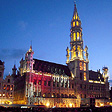MUSEUM
OF CHOCOLATE – BRUSSELS
Cocoa, and the Belgian Chocolate Praline
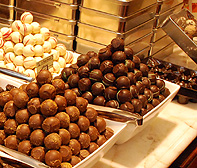 Chocolate
is a national passion in Belgium with more than two thousand chocolate
shops and more than
a few museums on the subject. The history
of chocolate goes back to the days of discovery and exploration, first
a bitter spice, then later a sweetened privilege of the royal class.
The particular form of Belgian Chocolates is the praline, a general
term for the filled chocolate in a molded shell made with a ground
paste of
nuts and sugar, taking the name “pralin” from a 17th Century
French sugar importer Marshal du Plessis-Praslin, whose chef came up
with the idea in the kitchen of his chateau. The
form of the candy commonly called Belgian Chocolate comes from the
invention of Swiss born chocolatier
Jean Neuhaus, who introduced the molded filled “Praline” his
Brussels shop in 1912. A stroll through the Royal Galleries St Hubert
in Brussels will surely test your sweet-tooth will-power where Neuhaus
and other chocolatiers have been tempting the bourgeois since the
days of King Leopold (see Royal
Galleries St Hubert ).
If you want to take home some Belgian Chocolates, you
need go no further than this candy wonderland, but if delving
deeper into the sweet secrets of chocolate, wander a little farther
to the
city’s
Grand Place.
Chocolate
is a national passion in Belgium with more than two thousand chocolate
shops and more than
a few museums on the subject. The history
of chocolate goes back to the days of discovery and exploration, first
a bitter spice, then later a sweetened privilege of the royal class.
The particular form of Belgian Chocolates is the praline, a general
term for the filled chocolate in a molded shell made with a ground
paste of
nuts and sugar, taking the name “pralin” from a 17th Century
French sugar importer Marshal du Plessis-Praslin, whose chef came up
with the idea in the kitchen of his chateau. The
form of the candy commonly called Belgian Chocolate comes from the
invention of Swiss born chocolatier
Jean Neuhaus, who introduced the molded filled “Praline” his
Brussels shop in 1912. A stroll through the Royal Galleries St Hubert
in Brussels will surely test your sweet-tooth will-power where Neuhaus
and other chocolatiers have been tempting the bourgeois since the
days of King Leopold (see Royal
Galleries St Hubert ).
If you want to take home some Belgian Chocolates, you
need go no further than this candy wonderland, but if delving
deeper into the sweet secrets of chocolate, wander a little farther
to the
city’s
Grand Place.
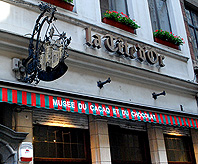 The
Museum of Cocoa and Chocolate of Brussels (in Dutch, the Het Museum
van Cacao en Chocolade or Le Musée du Cacao et du Chocolat in
French) is worth a stop for chocolate aficionados while in Brussels.
This private little museum of chocolate making is around the corner from
the town hall of the Grand Place on the Rue de la Tête d'Or.
One of the historic houses of old Brussels, the Falcon House was
built in
1697 by the De Valk (Falcon) family. A brewery once occupied the
premises in the 18th Century where a De Valk beer was brewed, but
the chocolate
museum, first conceived in 1998 by Madame Draps, from a long family
line of chocolatiers, has been located in the Falcon House since
2005.
The
Museum of Cocoa and Chocolate of Brussels (in Dutch, the Het Museum
van Cacao en Chocolade or Le Musée du Cacao et du Chocolat in
French) is worth a stop for chocolate aficionados while in Brussels.
This private little museum of chocolate making is around the corner from
the town hall of the Grand Place on the Rue de la Tête d'Or.
One of the historic houses of old Brussels, the Falcon House was
built in
1697 by the De Valk (Falcon) family. A brewery once occupied the
premises in the 18th Century where a De Valk beer was brewed, but
the chocolate
museum, first conceived in 1998 by Madame Draps, from a long family
line of chocolatiers, has been located in the Falcon House since
2005.
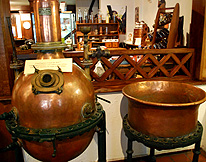 The
core of the museum is a chocolate making demonstration in the small
kitchen presented by a master chocolatier illustrating how Belgian
pralines are
made in the traditional way. The entrance fee includes a free sample
of chocolate and as much as you can take from the kitchen demonstration
as you watch the chocolate
go
through the stages from melted liquid to seashell molds and taste
the
rich results. The demonstration lasts about 15 minutes. While waiting
for the next demonstration to begin in your preferred language English
or French, or afterward, you can explore the two floors of exhibits.
Video presentations, chocolate memorabilia and poster art trace the
history of chocolate from the Aztecs and Mayans of South America
where the cocoa
plant was cultivated thousands of years ago, following its journey
of discovery and how cocoa came to Europe.
The
core of the museum is a chocolate making demonstration in the small
kitchen presented by a master chocolatier illustrating how Belgian
pralines are
made in the traditional way. The entrance fee includes a free sample
of chocolate and as much as you can take from the kitchen demonstration
as you watch the chocolate
go
through the stages from melted liquid to seashell molds and taste
the
rich results. The demonstration lasts about 15 minutes. While waiting
for the next demonstration to begin in your preferred language English
or French, or afterward, you can explore the two floors of exhibits.
Video presentations, chocolate memorabilia and poster art trace the
history of chocolate from the Aztecs and Mayans of South America
where the cocoa
plant was cultivated thousands of years ago, following its journey
of discovery and how cocoa came to Europe.
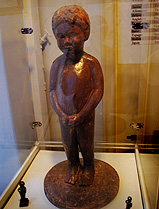 The
upper floor features a display of how chocolate was eaten back in the
15th Century when it first arrived in Europe. On the first
floor you’ll find the copper cooker vessel equipment for the
making of milk chocolate invented in Switzerland (see Nestle
Alimentary Museum and Maison
Caillier Gruyere) made from mixing
chocolate with a reduced milk under heat and pressure a canoe, representative
of that used in the cocoa producing countries of West Africa. The
upper
floors delve more into the history of cocoa, regions where it is
produced, and the effects of the cocoa trade in Europe and in Africa.
On display
are a collection of praline chocolate molds and porcelain ceramic
tea carafes and art nouveau cookie tins. Perhaps more curious among
the exhibits you’ll
find a replica of the famous peeing boy statue of Brussels, the Mannekin
Pis. This little guy can be found in various places around town,
a local symbol, often painted in various styles, but here, all in
chocolate.
The real statue is around the corner from the museum.
The
upper floor features a display of how chocolate was eaten back in the
15th Century when it first arrived in Europe. On the first
floor you’ll find the copper cooker vessel equipment for the
making of milk chocolate invented in Switzerland (see Nestle
Alimentary Museum and Maison
Caillier Gruyere) made from mixing
chocolate with a reduced milk under heat and pressure a canoe, representative
of that used in the cocoa producing countries of West Africa. The
upper
floors delve more into the history of cocoa, regions where it is
produced, and the effects of the cocoa trade in Europe and in Africa.
On display
are a collection of praline chocolate molds and porcelain ceramic
tea carafes and art nouveau cookie tins. Perhaps more curious among
the exhibits you’ll
find a replica of the famous peeing boy statue of Brussels, the Mannekin
Pis. This little guy can be found in various places around town,
a local symbol, often painted in various styles, but here, all in
chocolate.
The real statue is around the corner from the museum.
Visiting the Cocao and Chocolate Museum
The museum is open Tuesday to Sunday from 10am to 4:30pm, closed on Mondays except for public holidays. Adult admission is €5.50, Seniors and Students €4.50, children under 12 are free. © Bargain Travel Europe
Find best hotel and travel deals in Belgium on TripAdvisor
Web Info
Museum
of Cocoa & Chocolate
Neuhaus
Chocolate
These articles are copyrighted and the sole property of Bargain Travel Europe and WLPV, LLC. and may not be copied or reprinted without permission.
SEE ALSO:

